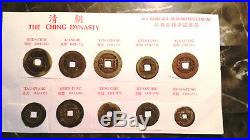


Only your assessment will make that determination. The coins in the photo are the ones you will receive. ” BOO CIOWAN” (Board of Revenue Mint). The Manchurian Mint name translates to Pao-Ch’uan, or ” the Fountain Head of the Currency”. All other mints have the mint name twice, in Manchu on left and Chinese on the right. “NING” (Ningpo in Chekiang). Mint names no longer appear in Chinese script. “BOO CIOWAN” (Board of Revenue Mint) The Manchurian Mint name translates to Pao-Ch’uan, or “The Fountain Head of the Currency”. HeCh’ien-lung is thought of as one of the most brilliant rulers in Chinese history. He was a patro of the arts, which a very high level during his reign. He was a patron of the arts, which reached a very high level during his reign. He is also one of the few Chinese emperors to abdicate the throne, which he did to honor K’ang Hsi (his father) by ending his reign just before is would have exceeded the reign of K’ang Hsi’s reign. “BOO CIOWAN” (Board of Revenue Mint in Bejing). The Manchu Mint name translates to Pao-Ch’uan, or “The Fountain Head of the Currency”. The Manchu Mint name translates to Pao-Su. “BOO SU” (Kiangsu Provincial mint). The one cash coins have the standard two character mint marks on the reverses, while higher denominations have four characters with extra two to show the denomination. “BOO YON” (Yunnan Mint). The Manchu Mint name translates to Pao-yun. “BOO YON” (Yunnan mint). The Manch Mint Name translates to Pao-yun. The Manchu mint name translates to Pao-yun. They were struck in very yellow brass, and tend to be very well made. Most were made in the Kwangtung province, and were probably first struck in 1889. He was only three years old when came to the throne, then forced to abdicate to the forces of the Republic 1912, but continued to live in the Imperial palace until 1924. UIn 1931 when the Japanese made him president of Manchukuo, and then changed his title to Emperor of Manchukuo in 1934, with reign title: K’ANG-TE. The coins pictured are the ones you receive. Please Note: Coins are not professionally graded, known as Raw Coins: All raw coins are not graded by us nor anyone else. We do not make any representation as to what a coin would grade by a professional grading service or others. We do absolutely 100% guarantee the authenticity of any ungraded coin. Please examine the coin images thoroughly and make your own assessment. I do my best to describe all items as accurately as possible and to the best of my ability. Photos are part of the description. The item “China Ching Dynasty (1644-1912) 10 Emperors’ Cash, Compleate Set of 10 Coins” is in sale since Thursday, May 2, 2019. This item is in the category “Coins & Paper Money\Coins\ World\Asia\China\Empire (up to 1948)”. The seller is “high88top1″ and is located in Charlotte, North Carolina. This item can be shipped to United States.
- Country/Region of Manufacture: China
- Certification: Uncertified
- Year: 1644-1912
- Circulated/Uncirculated: Circulated

